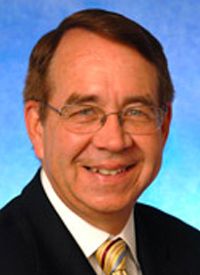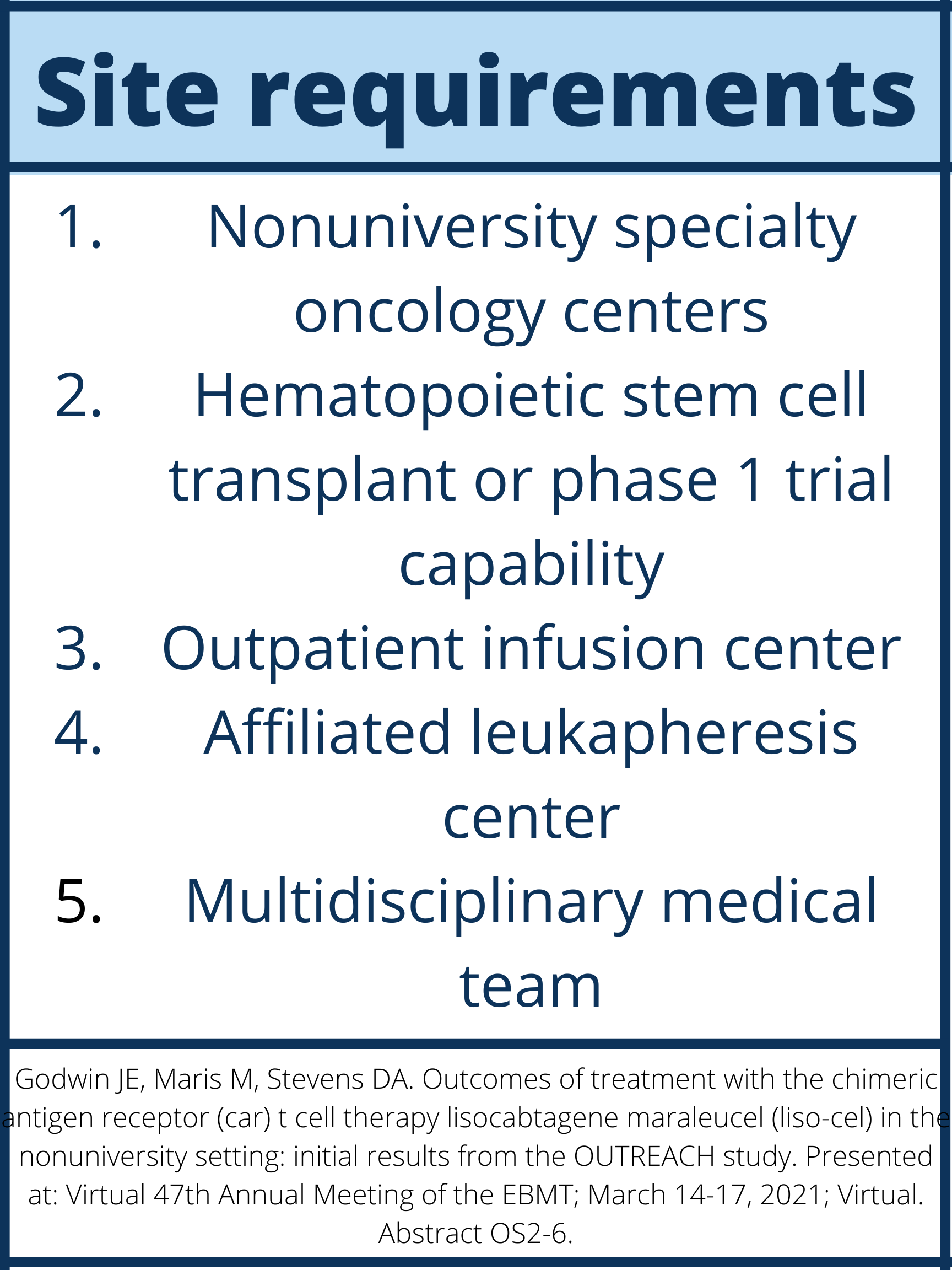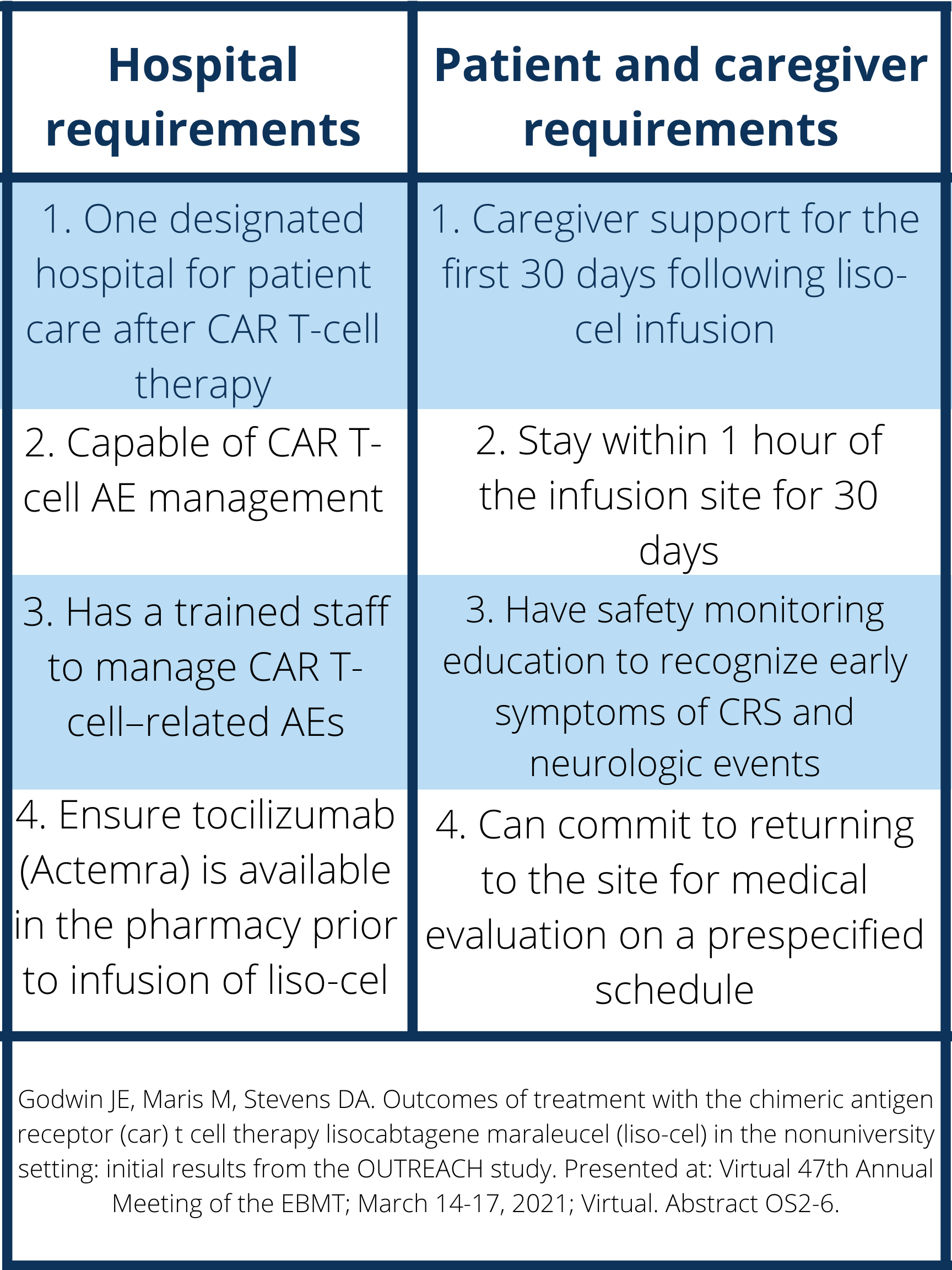Liso-Cel Administration in Relapsed/Refractory LBCL Successful in Inpatient, Outpatient Settings at Nonuniversity Centers
Lisocabtagene maraleucel was successfully administered in patients with relapsed/refractory aggressive large B-cell lymphoma who were at nonuniversity medical centers in both the outpatient and inpatient settings through the use of standard operating procedures and multidisciplinary teams
John E. Godwin, MD

Lisocabtagene maraleucel (liso-cel; Breyanzi) was successfully administered in patients with relapsed/refractory aggressive large B-cell lymphoma who were at nonuniversity medical centers in both the outpatient and inpatient settings through the use of standard operating procedures and multidisciplinary teams, according to results from the OUTREACH trial.1
The findings, which were presented at the Virtual 47th Annual Meeting of the EBMT, showed that at the end of the data cutoff, any-grade and grade 3 or higher cytokine release syndrome (CRS) or neurologic events (NEs) occurred in 48% (n = 22) and 7% (n = 3) of patients treated with liso-cel in both the outpatient and inpatient settings.
When stratified by outpatients and inpatients, all-grade and grade 3 or higher CRS or NEs occurred in 50% (n = 15) and 7% (n = 2) of those treated in the outpatient setting; in the inpatient setting, these rates were 44% (n = 7) and 6% (n = 1).
Additionally, efficacy data showcased that the best objective response rate (ORR) with liso-cel was 77% and the complete response (CR) rate was 57% in the overall population; similar results were observed in the outpatient (ORR, 79%; CR, 61%) and inpatient (ORR, 75%; CR, 50%) settings. Ninety-two percent of patients with at least 6 months of follow-up had an ongoing CR as of the cutoff date.
“These data support the safety of liso-cel administration at nonuniversity medical centers and in the outpatient setting,” lead study author John E. Godwin, MD, hematology of medical oncology at Providence Cancer Institute Franz Clinic, said in a virtual presentation of the data.
CAR T-cell therapy is most often administered as inpatient treatment at university medical centers because of concerns about monitoring for CRS and NEs. Therefore, infusion and monitoring of patients who receive this modality at nonuniversity medical centers and in outpatient settings have not been studied.
Liso-cel is a CD19-directed, defined composition, 4-1BB CAR T-cell product that is administered as separate equal target doses of CD8+ and CD4+ CAR+ T cells. The defined composition allows for a consistent administered CD8+ and CD4+ CAR+ T-cell dose, as well as a low variability in the CD8+/CD4+ ratio. Moreover, Godwin noted that the dose and ratio of CD8+ and CD4+ CAR+ T cells could influence the incidence and severity of CRS and NEs.
Based on results of the multicenter phase 1 TRANSCEND NHL 001 study (NCT02631044), the FDA approved liso-cel for the treatment of adult patients with certain types of large B-cell lymphoma who have not responded to, or who have relapsed after, at least 2 other types of systemic therapy. In the trial, liso-cel elicited an ORR of 73% and a CR rate of 53%; the median time to first CR or partial response was 1 month.2
In the OUTREACH trial, investigators examined the preliminary safety and efficacy outcomes of liso-cel in patients with relapsed/refractory LBCL in both the inpatient and outpatient setting at nonuniversity medical centers.
Following enrollment and leukapheresis, bridging therapy was permitted simultaneously with liso-cel manufacturing. Lymphodepletion was comprised of fludarabine at 30 mg/m2 and cyclophosphamide at 300 mg/m2 for 3 days. Liso-cel was given 2 to 7 days following lymphodepletion at 100 x 106 CAR+ T cells (n = 46). Patients were followed on study for 2 years, and also for long-term follow-up of up to 15 years after the last liso-cel infusion.
To be eligible for enrollment, patients had to have LBCL after 2 or more prior lines of therapy. Prior autologous transplant and secondary central nervous system lymphoma was permitted. Patients also were required to have an ECOG performance status of 0 to 1, a creatinine clearance level higher than 30 mL/min/1.73 m2, a left ventricular ejection fraction at 40% or lower. There was no lower threshold for absolute lymphocyte count, absolute neutrophil count, platelets, or hemoglobin.
Investigators had the discretion to treat patients in the inpatient setting, based on the presence of disease characteristics or the patient’s clinical status.
Godwin reviewed the various site and patient requirements the study made for outpatient monitoring:
Site requirements:
FIGURE1: Site requirements for for outpatient monitoring.

Hospital requirements and patient and caregiver requirements:
FIGURE2: Hospital requirements and patient and caregiver requirements

Additionally, Godwin added, patients could also be considered outpatients if they received liso-cel in an inpatient facility with subsequent discharge the same day at the end of the observation period.
Outpatient treatment facilities were considered hospitals with outpatient infusion centers (single entity) and oncology clinic and associated hospitals (dual entity). In the outpatient setting, liso-cel was administered and patients were observed on the same day as infusion before being released. Patients and caregivers were educated to recognize the early signs of CRS and NEs and had to remain within 1 hour of the infusion site for 30 days.
Patients were also monitored daily for the first 7 days through clinic visits or phone calls, followed by a twice-weekly schedule during the first month. At the first sign of fever, CRS, or NEs, patients were hospitalized.
The primary end point of the trial was incidence of grade 3 or higher CRs, NEs, prolonged cytopenias through day 29, and infections. Secondary outcome measures included AEs, ORR, CR, duration of response, progression-free survival, overall survival, and pharmacokinetics.
Baseline characteristics in the OUTREACH population, comprising both outpatient (n = 30) and inpatient (n = 16) groups, were similar to that of the TRANSCEND NHL 001 trial population (n = 269).
In OUTREACH, the median age was 63 years (range, 34-83), and 46% of patients were older than 65 years. Most patients (74%) were not Hispanic or Latino, and patients had a histology of diffuse large B-cell lymphoma (DLBCL) not otherwise specified (63%), DLBCL transformed from indolent histologies (20%), or high-grade B-cell lymphoma/primary mediastinal large B-cell lymphoma/follicular lymphoma grade 3B (17%).
Additionally, all patients had an ECOG performance status of 0 or 1, the median number of prior therapies was 2 (range, 2-6), and 20% of patients underwent prior HSCT (20%). Eighty-five percent of patients had chemotherapy-refractory disease, 33% had a lactate dehydrogenase level of at least 500 UL, 40% had a sum of the product of perpendicular diameters at least 50 cm2, and 59% had a C-reactive protein level of at least 20 mg/L.
The incidence of treatment-emergent AEs in outpatients and inpatients proved to be similar, with a slightly higher frequency of severe cytopenias reported in inpatients, Godwin explained.
Further results indicated that any-grade CRS occurred in 41% of patients overall, but none were grade 3 or higher; these rates were 43% in the outpatient setting and 37.5% in the inpatient setting. The median time to onset of CRS was 4 days (range, 1-9) overall; this was 5 days (range, 2-9) and 2.5 days (range, 1-3) in the outpatient and inpatient settings, respectively.
All-grade NEs were reported in 30% of patients overall and 7% of these were grade 3 or higher. In the outpatient setting, these rates were 30% and 7%, respectively; in the outpatient setting, these rates were 31% and 6%, respectively. The median time to onset of NEs were 9 days (range, 3-16) overall, 9 days (range, 6-14) in the outpatient setting, and 10 days (range, 3-16) in the inpatient setting.
Thirteen percent of patients overall experienced grade 3 or higher infection, and 24% of patients had prolonged grade 3 or higher cytopenias; both of these were more common in the outpatient setting (17%) and (30%).
Overall, treatment for CRS was tocilizumab and steroids (9%) or tocilizumab alone (4%), and 11% of NEs were treated with steroids only. In the outpatient setting, CRS treatment comprised tocilizumab in 3% of patients, as well as tocilizumab and steroids in 10%; NE treatment was steroids, which were used in 10% of patients. In the inpatient setting, CRS was managed with tocilizumab alone in 6% of patients and with steroids in 6% of patients; NEs were managed in 12.5% of patients.
Investigators evaluated the initial hospitalizations in outpatients. Any hospitalizations occurred in 63% of patients, and 27% occurred on study day 4 or earlier; 53% were hospitalizations due to an AE, while 10% were due to another event. ICU admissions following liso-cel administration occurred in 3% of patients. The median length of hospital stay was 6 days (range, 1-28) and the median time to hospitalization was 5 days (range, 2-61).
References
- Godwin JE, Maris M, Stevens DA. Outcomes of treatment with the chimeric antigen receptor (car) t cell therapy lisocabtagene maraleucel (liso-cel) in the nonuniversity setting: initial results from the OUTREACH study. Presented at: Virtual 47th Annual Meeting of the EBMT; March 14-17, 2021; Virtual. Abstract OS2-6.
- Abramson JS, Palomba ML, Gordon LI, et al. Pivotal safety and efficacy results from Transcend NHL 001, a multicenter phase 1 study of lisocabtagene maraleucel (liso-cel) in relapsed/refractory (R/R) large B cell lymphomas. Blood. 2019;134(suppl 1):241. doi:10.1182/blood-2019-127508



